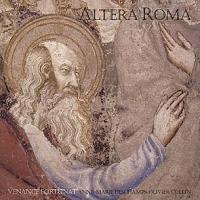
Many delights
Performances of 14th century music
by Venance Fortunat -
appreciated by REX HARLEY'... the sound they make is quite breath-taking.'
|

|
In 1325 Philippe de Vitry produced his famous treatise, in which he coined
the term Ars Nova to describe the latest developments in musical
composition, by which time, further south in Avignon, the Papacy had been
settled for the past twenty years. Its so-called 'Babylonian captivity'
did not come to an end until 1327. The Pope returned to Rome, leaving behind
a magnificent building, the Palais des Papes, whose walls had been decorated
by some of the foremost artists of the age. Indeed, there are those who
suggest that the Italian Renaissance actually began in Avignon. Thus ended
the brief period in which Avignon had become l'Altera Roma:
the other Rome.
The music of Ars Nova is often compared with the products of the
Late Gothic in architecture, with which it coincides chronologically. While
there is some validity in this comparison, there are also significant differences.
The buildings of the Late Gothic start to demonstrate a 'showing off'
of architectural skill and elaboration, in which the underlying structure
becomes almost secondary to the lavish display which encrusts it. The classic
example of this is the pendant vault, which ends up like a series of heavily
decorated stalactites; the architectural reason for the vaults themselves
has almost been forgotten. While it is true that Ars Nova is a form
whose internal structures in some ways parallel architecture, and that the
vocal lines are often, but not always, elaborate, it is not a musical
form which has started to tilt towards the exaggerated and bizarre. That
comes a little later with the Ars Subtilior!
Continue >>
Copyright © 6 November 2002
Rex Harley, Cardiff, UK

|

